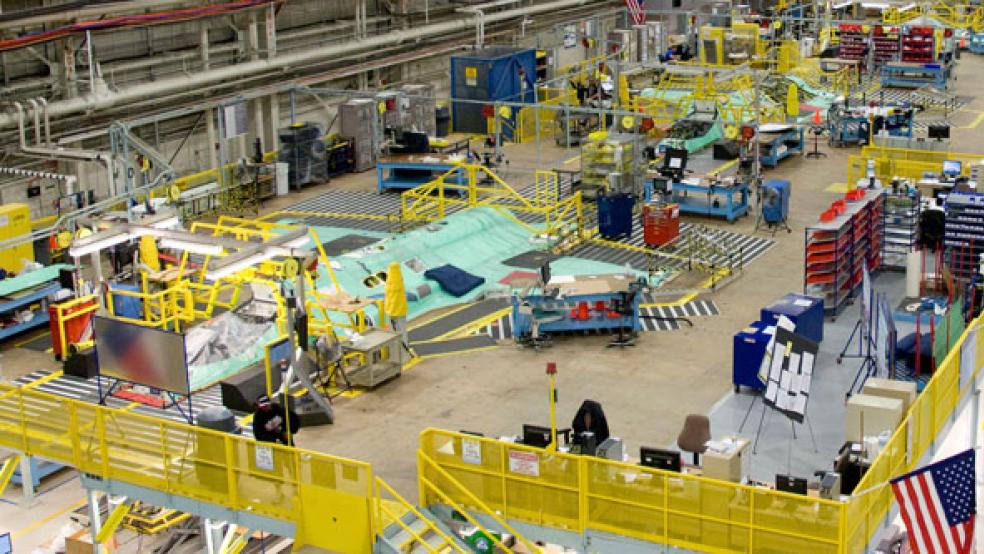Defense Secretary Chuck Hagel told lawmakers Wednesday that the sequester, along with continued budget uncertainty, was making it difficult for the Pentagon to properly plan and prepare to confront 21st Century threats.
“We are now in a different fiscal environment dealing with new realities that will force us to more fully confront these tough and painful choices, and to make the reforms we need to put this Department on a path to sustain our military strength," Hagel told the Senate budget committee. "The onset of these resource constraints has already led to significant and ongoing belt-tightening in military modernization, force structure, personnel costs, and overhead expenditures."
Hagel said the Pentagon would be forced to make cuts to personnel benefits, reduce force size, and delay training of new recruits. But some of the most dramatic cuts are expected to occur in the acquisitions budget, which pays contractors for the machinery they produce and the services they provide.
Earlier in the year, there was concern that the $43.2 billion removed from DOD’s budget this year combined with an additional $600 billion over the next decade, would hamstring the broader economic recovery. As the chart below shows, DOD spending accounts for nearly 6 percent of gross domestic product.
Hubert van Tuyll, a professor of economics at Georgia Regents University and co-author of Castles, Battles, and Bombs: How Economics Explains Military History, said he was not concerned about DOD dragging down the broader economy.
“When you have a big defense drawdown, it doesn’t really hurt the overall economy that much. But when you have a drawdown, the military establishment has to make a decision to lose people or equipment,” van Tuyll told The Fiscal Times. “It’s the equipment that will go first.”
This is bad news for defense contractors. In the coming years, the massive post-9/11 military industrial complex will be forced to confront a series of challenges, from the drawdown to a poorly defined mission, that will eat away at their bottom lines. This will force defense contractors to make tough decisions regarding their futures their research and development budgets shrivel.
POST-9/11 BOOM TURNS BUST
Large and small defense contractors made money hand-over-fist after the September 2001 terrorist attacks. The chart below shows just how dramatic their revenue growth has been.
This sharp increase has led to massive profits. In 2002, the combined profits of the five largest U.S.-based DOD contractors - Lockheed Martin, Northrop Grumman, Boeing, Raytheon and General Dynamics - totaled an inflation-adjusted $2.4 billion. Ten years later, revenues for these five companies jumped 450 percent to $13.4 billion.
According to retired Army Colonel Doug Macgregor, these enormous profits are quickly becoming a thing of the past. “The traditional way of doing business … is not going to last. It’s not going to last because we can’t afford it.
MEN OVER MACHINES
The Pentagon has yet to specially outline how it will make funding decisions. According to van Tuyll, history illustrates how the military makes tough spending choices. During the Great Depression, the Army was forced to cut costs that rose during the First World War.
“The U.S. army was faced with a similar problem to what they’re facing now,” he said. “Douglas MacArthur and George C. Marshall decided it takes much longer to train new officers than it does to make an airplane, a tank or a gun. So they cut equipment”
This strategy paid off during World War II. The officers needed to quickly train a fighting force capable of defeating Hitler’s war machine was already in place. The subsequent manufacturing push helped to end the Great Depression.
A NEW REALITY
The contractors are also working against a shift from a large war model to one that uses smaller forces and drones to conduct security operations, Macgregor said. This works against contractors’ preferred way of doing business: big orders paid for by big contracts for big items like planes, tanks, and weapons.
“"We can’t afford to buy 10,000 copies of [weapons or vehicles] any more. The old industrial age model of manufacturing thousands of copies is over," he said.
In the coming years, Macgregor said that DOD is likely to give out small initial contracts first. If the Pentagon likes the result, it will order more. If not, it won’t pay a second contract.
“Contractors don’t like the idea of creating smaller numbers before big orders because they’re not going to get the kind of profits you did in the past. Everyone got rich off the old strategy,” he said.
Macgregor added that DOD’s failure to articulate how it plans to drawdown equipment allows these companies to continue to abuse the industrial age model. As long as the military keeps ordering unnecessary vehicles like the Abrams tank, contractors are making money by exploiting an outdated war model.
“Industry will begin to do what is has always done,” he said. “Everyone is going to squeeze out profits from whatever they got before they can’t squeeze any more.”
It’s not just the lack of large orders that will take a toll on contractors. Research and development dollars coming out of the Pentagon are likely to dry up as well. These grants allow companies to develop dual-use technology that produces two independent revenue streams. For instance, the Pentagon could pay Boeing to develop an engine for a cargo plane that could also be sold to a commercial airline.
“The American aviation industry got a head start after World War II through what was essentially a military subsidy,” Georgia Regent’s van Tuyll said. “If you learn how to build a good military engine, you can stick it on a commercial airplane.”
FORGING ON
For now, defense stocks of major defense companies hold steady. But Macgregor believes all of these factors will eventually lead to job losses once the real bloodletting begins.
Jurgen Brauer, professor of economic at Georgia Regents University and co-author of Castles, Battles, and Bombs, said these companies needed to reinvent themselves. A prime example how a defense contractor can evolve is General Electric. The company made enormous profits and technological advances during World War II. Once the war was won, it began to invest in and acquire other businesses. Now it offers everything from financial management to refrigerators along with military jet engines.
"Last time around, after the end of the Cold War, we saw a huge consolidation (mergers & acquisition) among the major contractors," Brauer, who is teaching overseas, wrote in an email to The Fiscal Times. "Unlike Europe, there isn't much more to consolidate among the U.S. 'majors' so they may seek even more overseas contracts or, for those with a civilian market portfolio, are likely to shift more deliberately and clearly into nonmilitary work."





